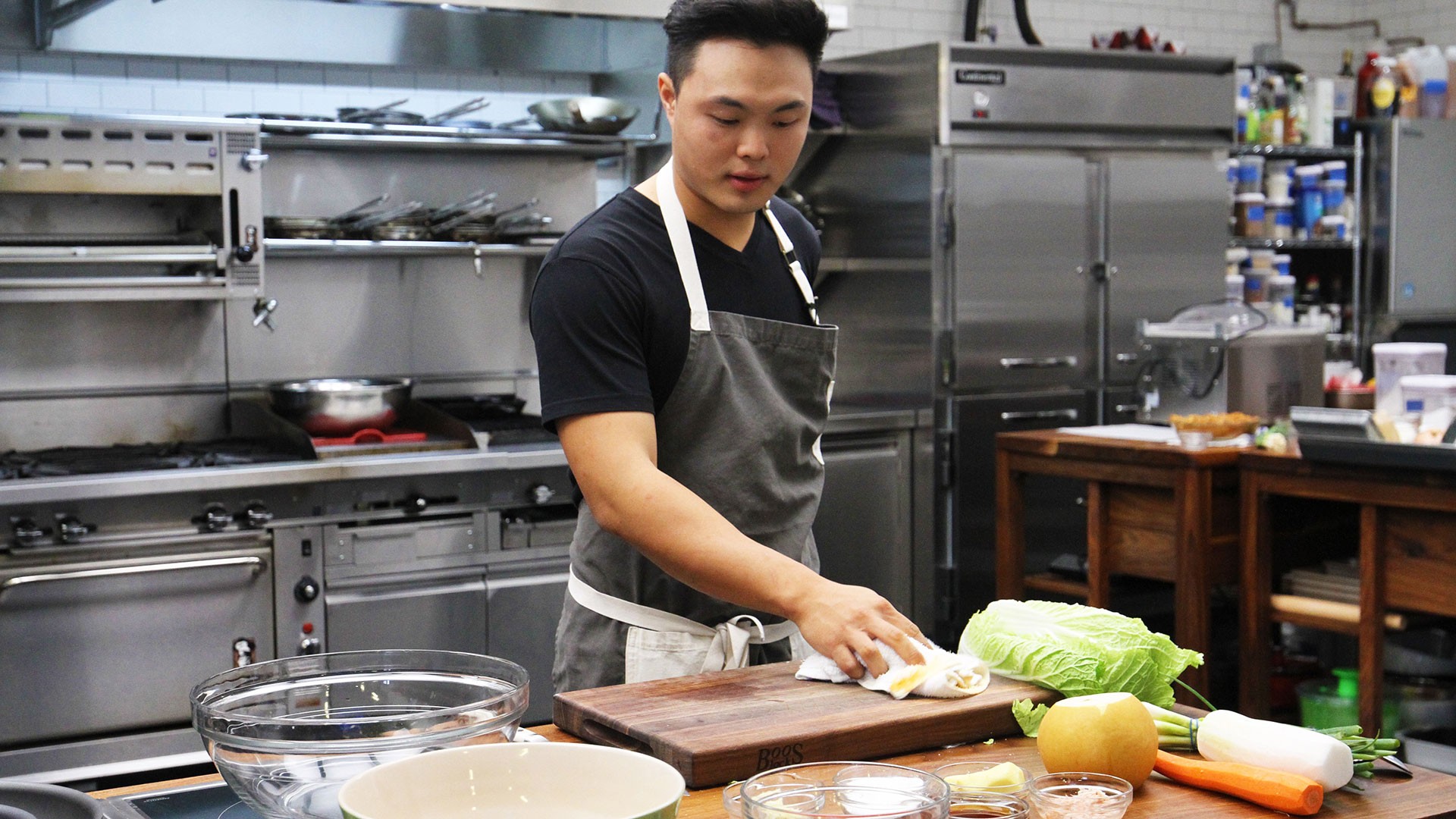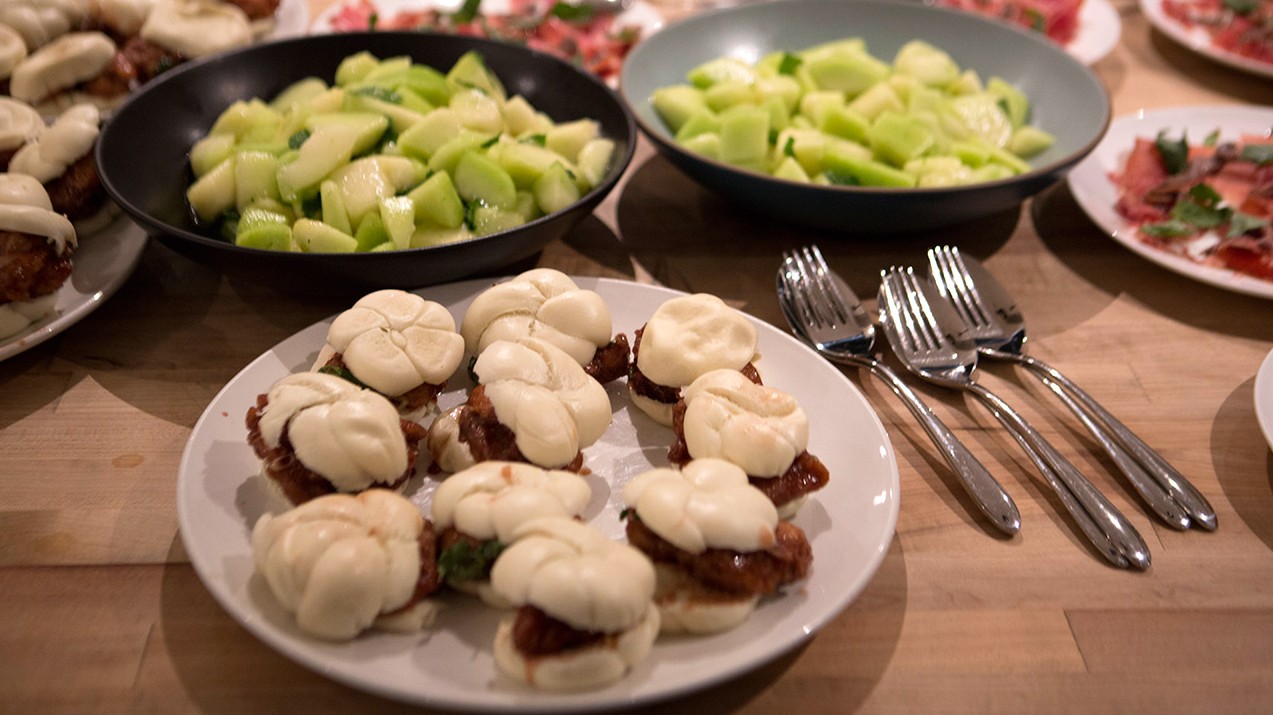Screenshot via Netflix
Netflix is no stranger to the rom-com. In the past year alone, it's cranked out so many that people across the internet have hailed the service's "rom-com revival." Its experience with food shows is similarly well-traversed, from the high-drama Chef's Table to the homey Salt, Fat, Acid, Heat. It's no surprise, then, that Netflix has brought the two together in the much-anticipated Always Be My Maybe, directed by Nahnatchka Khan of Fresh Off the Boat.The movie—which dropped on Netflix today and stars Ali Wong and Randall Park as a celebrity chef and her much more average boyfriend, and features a surprise appearance from Keanu Reeves—explores the difficulties of adult relationships, in which love can be at odds with success and ambition, and food doesn't always bring two people together.The movie starts in San Francisco in the mid-90s, when a young Sasha Tran (Ali Wong) and Marcus Kim (Randall Park) first find their life-changing friendship through food. Sasha, a latchkey kid, cooks and eats on her own; precocious in the kitchen, she fries Spam and serves it with a mound of furikake-sprinkled rice. But when Marcus shows up at the door with an offering of kimchi stew, Sasha is welcomed into the Kim family, where she watches Marcus's mom cut scallions with scissors while cooking. Over time, friendship turns into romance, but the memory of joining each other at the table remains its basis.After the death of Marcus's mom, they have a falling out and lose touch. Sasha becomes the celebrity chef behind Knives + Mercy, a trendy "nondenominational Vietnamese" restaurant in Los Angeles, with a life of black car rides to openings and events; Marcus, meanwhile, still lives and works with his dad, spending his seemingly ample free time smoking weed with his high school bandmates. When Sasha comes home to open a new restaurant, the two have a tenuous reunion. Over meals and visits to the farmer's market, their feelings return and mature.But while their childhood experiences might have been similar—and as much as Sasha wants to share her new world with Marcus—the act of eating together only reinforces the differences they've developed after 16 years apart. To say that food brings people together is an easy narrative, but Always Be My Maybe doesn't fall into that. Instead, it allows food to also be a point of disagreement and a stumbling block, highlighting their divisions in money, ambition, and success—at some points, food undermines the possibility of a relationship. Sasha has all the conventional markers of success. She's opening her second restaurant, then a third in New York on its heels. She has an assistant, and despite the short time she's in San Francisco, she installs a new air conditioning unit in her huge rental home anyway.Food, for Sasha, is a bragging right. By making it a career, it symbolizes upward mobility, and tangible proof that her life isn't what it used to be. Despite growing up on Spam, she now sneers at Vienna sausages; when she returns to the dim sum place of her childhood, her immediate remark is how bad it was (though she soon finds herself pleasantly surprised by its dishes). In the way she eats and cooks, food serves as a way to distance herself from a childhood when she felt abandoned and discouraged by her parents' absence.Marcus, meanwhile, is stuck, and in more ways than just his diet. His car, band, and friends are all the same as when he was a teenager; he seems fine continuing with his father's HVAC business. Most people maintain a taste for their familiar childhood foods, sure, but Marcus is more hesitant to new things than most—even resisting the idea of cold brew coffee, as his bandmate points out. Food marks just how comfortable Marcus is with everything exactly as-is, without much desire to change, grow up, or even move out. Food might mark Sasha's success, but for Marcus, it reinforces a failure to launch.When Marcus and Sasha reconnect, Marcus quickly becomes insecure about his job and class status, a divide that's widened by the types of food they eat and how they eat them. At a $6,400 dinner, for example—in a modern restaurant called Maximal, where one dish is edible bubbles—it's immediately clear that Marcus hasn't attained the same markers of success that Sasha has. Food is the way that Sasha tries to get Marcus out of his rut, but as she tries to pull him into monochromatic meals and conceptual dinners, Marcus resists in concept, in cost, and in taste. He thinks food should be affordable and straightforward; he wants his Asian food "authentic" like his mother's, not "elevated" like Sasha's.
Sasha has all the conventional markers of success. She's opening her second restaurant, then a third in New York on its heels. She has an assistant, and despite the short time she's in San Francisco, she installs a new air conditioning unit in her huge rental home anyway.Food, for Sasha, is a bragging right. By making it a career, it symbolizes upward mobility, and tangible proof that her life isn't what it used to be. Despite growing up on Spam, she now sneers at Vienna sausages; when she returns to the dim sum place of her childhood, her immediate remark is how bad it was (though she soon finds herself pleasantly surprised by its dishes). In the way she eats and cooks, food serves as a way to distance herself from a childhood when she felt abandoned and discouraged by her parents' absence.Marcus, meanwhile, is stuck, and in more ways than just his diet. His car, band, and friends are all the same as when he was a teenager; he seems fine continuing with his father's HVAC business. Most people maintain a taste for their familiar childhood foods, sure, but Marcus is more hesitant to new things than most—even resisting the idea of cold brew coffee, as his bandmate points out. Food marks just how comfortable Marcus is with everything exactly as-is, without much desire to change, grow up, or even move out. Food might mark Sasha's success, but for Marcus, it reinforces a failure to launch.When Marcus and Sasha reconnect, Marcus quickly becomes insecure about his job and class status, a divide that's widened by the types of food they eat and how they eat them. At a $6,400 dinner, for example—in a modern restaurant called Maximal, where one dish is edible bubbles—it's immediately clear that Marcus hasn't attained the same markers of success that Sasha has. Food is the way that Sasha tries to get Marcus out of his rut, but as she tries to pull him into monochromatic meals and conceptual dinners, Marcus resists in concept, in cost, and in taste. He thinks food should be affordable and straightforward; he wants his Asian food "authentic" like his mother's, not "elevated" like Sasha's. All of this, of course, is set against the backdrop of San Francisco in 2019, and accordingly, the movie grapples with the idea of food as a symbol of larger class tensions. The types of businesses being built in neighborhoods indicate who's moving into them, and Marcus, a lifelong San Franciscan, is skeptical of those developments. For him, food businesses are an emblem of a changing city—one that, as we know from real life, is harder and harder to inhabit by people like Marcus, locals whose jobs can't keep pace with the swelling salaries of Silicon Valley.But Sasha is a catalyst in the boom of businesses targeted at the city's wealth tech elites. Her restaurant, Saintly Fare, is one with communal tables, expensive Gubi chairs, and an employee at the door who describes Marcus as extremely "middle-class." When Marcus makes jokes about "hipster" food establishments—the line "If I see another hipster opening a coffee shop / I'll make a body drop / with my karate chop" features in one of his songs—it's implicitly a jab at Sasha and her clientele. Food might highlight how little Marcus's life has changed, but it's also proof of just how much the city has changed around him.Food is where Sasha and Marcus's fundamental differences in world views play out. This is where Always Be My Maybe feels refreshing compared to rom-coms before it: Instead of a ridiculous lie or an unlucky stroke of fate pulling two people apart, what undermines Sasha and Marcus is reality. Sometimes, no matter how much you love someone, your perspectives or timelines just don't line up, and food is the way Always Be My Maybe brings up the challenges of careers, goals, and futures that become increasingly glaring the higher you creep in age—when the career that you want to build, and the things you want to prioritize, feel even more clear than they did in your youth. Luckily, because it's a rom-com, we know, at its heart, that everything will work out.Eventually, of course, they both realize that they've got to meet each other halfway: Marcus needs to step out of his comfort zone, but Sasha, too, needs to remember that not everything is fancy dinners and tasting menus. It's less about forcing each other to change and more about seeing that neither of their approaches—to food and to life—need to be so rigid. Love can be found at a $6,000 dinner, but it can also be found at an awkward trip to Burger King.Follow Bettina Makalintal on Twitter.
All of this, of course, is set against the backdrop of San Francisco in 2019, and accordingly, the movie grapples with the idea of food as a symbol of larger class tensions. The types of businesses being built in neighborhoods indicate who's moving into them, and Marcus, a lifelong San Franciscan, is skeptical of those developments. For him, food businesses are an emblem of a changing city—one that, as we know from real life, is harder and harder to inhabit by people like Marcus, locals whose jobs can't keep pace with the swelling salaries of Silicon Valley.But Sasha is a catalyst in the boom of businesses targeted at the city's wealth tech elites. Her restaurant, Saintly Fare, is one with communal tables, expensive Gubi chairs, and an employee at the door who describes Marcus as extremely "middle-class." When Marcus makes jokes about "hipster" food establishments—the line "If I see another hipster opening a coffee shop / I'll make a body drop / with my karate chop" features in one of his songs—it's implicitly a jab at Sasha and her clientele. Food might highlight how little Marcus's life has changed, but it's also proof of just how much the city has changed around him.Food is where Sasha and Marcus's fundamental differences in world views play out. This is where Always Be My Maybe feels refreshing compared to rom-coms before it: Instead of a ridiculous lie or an unlucky stroke of fate pulling two people apart, what undermines Sasha and Marcus is reality. Sometimes, no matter how much you love someone, your perspectives or timelines just don't line up, and food is the way Always Be My Maybe brings up the challenges of careers, goals, and futures that become increasingly glaring the higher you creep in age—when the career that you want to build, and the things you want to prioritize, feel even more clear than they did in your youth. Luckily, because it's a rom-com, we know, at its heart, that everything will work out.Eventually, of course, they both realize that they've got to meet each other halfway: Marcus needs to step out of his comfort zone, but Sasha, too, needs to remember that not everything is fancy dinners and tasting menus. It's less about forcing each other to change and more about seeing that neither of their approaches—to food and to life—need to be so rigid. Love can be found at a $6,000 dinner, but it can also be found at an awkward trip to Burger King.Follow Bettina Makalintal on Twitter.
Advertisement
Advertisement

Advertisement

